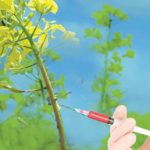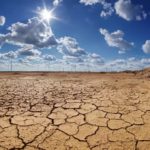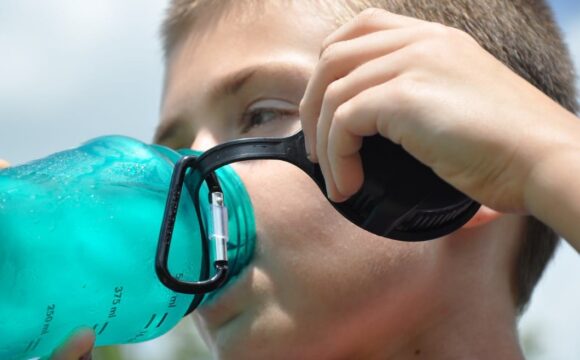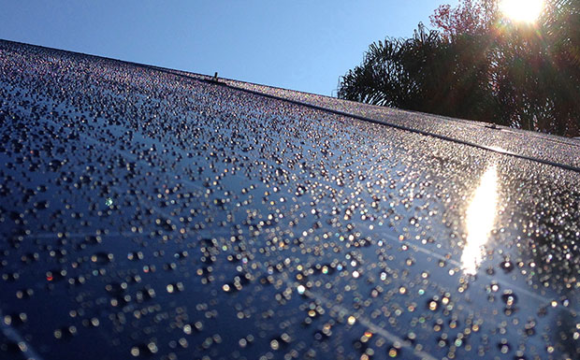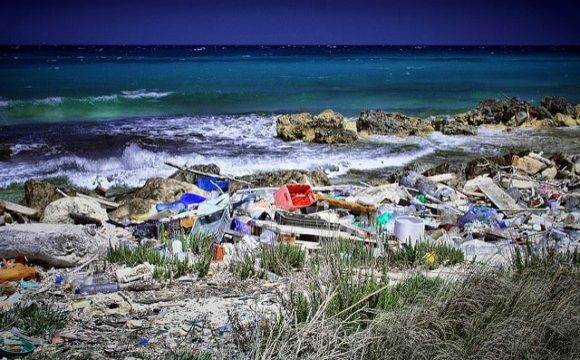In our search for a clean and renewable energy source we have developed and commercialized many energy harvesting technologies such as solar, wind, biogas etc. However, harvesting energy from evaporating water has received little attention comparatively. Every day, the sun heats up enough water surfaces to produce enormous amount of vapour. New research shows that this natural process can produce a lot of electricity if we can harness it.
This new method of harvesting energy is in very early stages. The research carried out at the Columbia University in the US showed that the ability to harvest evaporation energy from most of the existing lakes and reservoirs in the US, could generate 325 gigawatts (2.85 million megawatt hours per year). This could power about 70 percent of the US.

Miniature model of an evaporation engine. The engine sits on the surface of water (blue), and when water on the surface below the device evaporates, it creates a piston-like back and forth motion. When connected to a generator, that motion produces electricity.
(Image source: Xi Chen)
Study author and Columbia University biophysicist Ozgur Sahin, is the developer of the small “evaporation engine”. The underlying concept involves a material that changes size when a lot of water is present inside it, which in Sahin’s case, the materials were tiny spores. These spores absorb water and expand. When it’s hot, the water evaporates and the spores shrink. Hence, if you think of the spores as a muscle that contracts and elongates, it can be connected to a generator that produces electricity from this motion, and then we harvest energy from that process. The “evaporation engine” is placed on the surface of water. As water from the surface enters the device, it changes the shape of the spores, which creates electricity. The spores are also connected to shutters that control how much water evaporates. This means that we can control how much energy is generated, and controlling evaporation also helps in water conservation.
The same team also created another model, a mill with spores on it, half in a humid environment, with the other half in a dry environment. They connected this model to tiny wheels of a toy car, which was powered from the evaporation process of the energy harvesting device.

Evaporation engine prototypes use materials that expand and contract like muscles
(Image source: Xi Chen)
Areas with water surfaces which have high potential, are interestingly, areas where water is scarce. “These are typically places where the air is dry and there is a lot of sunlight,” Sahin says. “This combination enhances the power output from a given area of water surface. Note that the process of harvesting energy from evaporation will reduce the evaporation rates and therefore contribute to water savings in these regions.”
While slow progress is being made to develop the equipment for these energy harvesting devices, even less is known about the availability, reliability, and potential for this currently unexploited resource. However with all the water being returned to its source eventually, it is questionable how such evaporation farms might affect the weather, and what other environmental effects might develop, after all, the planet is 70% water. Nonetheless, the researchers claim the effects would be negligible in cases of water surfaces with an area of less than 500 kilometres square.
More research is soon to follow, where meanwhile, the team is working on developing materials that can be manufactured on a large scale, and want to test their engine on a larger body of water, like a pool. While this study was performed for the US, for a tropical and densely populated country like India, such energy harvesting technologies from water evaporation would be a boon.
References:
Cavusoglu, A. H., Chen, X., Gentine, P., & Sahin, O. (2017). Potential for natural evaporation as a reliable renewable energy resource. Nature Communications, 8.
https://www.theverge.com/2017/9/26/16273388/renewable-energy-natural-water-evaporation
https://gizmodo.com/could-evaporating-water-be-the-next-big-thing-in-renewa-1818780636




